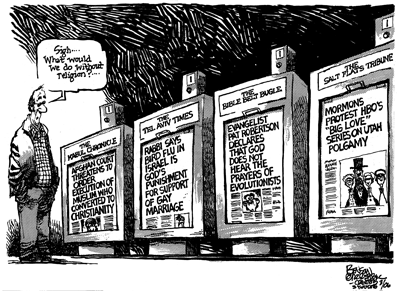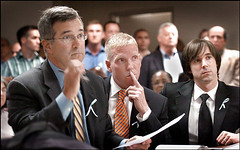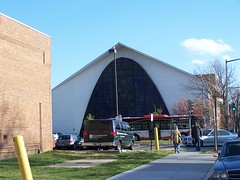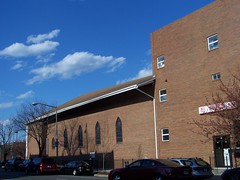Religion and politics and neighborhood improvement
 Editorial cartoon by Steve Benson.
Editorial cartoon by Steve Benson.We know that religion and politics often don't mix too well, ranging from the latest ridiculous pronouncement by Pat Robertson, to the thousands of people killed in the name of religion, to churchly preferences for continued squalor in DC's changing neighborhoods.
On Tuesday, I attended a Board of Zoning Adjustment hearing (which is why I didn't blog) relating to the Brookland Union Baptist Church and their desire for an adjacent parking lot. I didn't stay to the end, but it was ugly, because the church was completely unprepared, and stated that it believed that it had an exemption from zoning regulations because of this federal law: Religious Land Use and Institutionalized Persons Act of 2000.
The pastor said someone from DCRA gave him this statute and said they were exempt. The chair of the BZA wasn't familiar with this law, but in any case, "freedom of assembly for religion" doesn't mean having the unfettered right to parking (unless there is some religion based upon car-worship). The church ended up being denied, which was no surprise, given their lack of preparation. But that doesn't prevent them from trying again (and again, and again).
Yesterday, according to the Washington Post, in "In Shaw, Pews vs. Bar Stools," the Alcoholic Beverage Control Board held the first of many hearings about the proposed Be Bar on 9th Street NW. There are many issues involved here, but one is about change, and the other is about commercial district revitalization. Temperance laws from almost a century ago shape how we address these issues today.
 Michael Watson, far right, hopes to open Be Bar in Shaw despite opposition, with his business partner Tom McGuire, center, and their attorney Andrew Cline, left, at the ABC hearing on Wednesday April 19th, 2006. Photo: Gerald Martineau -- The Washington Post.
Michael Watson, far right, hopes to open Be Bar in Shaw despite opposition, with his business partner Tom McGuire, center, and their attorney Andrew Cline, left, at the ABC hearing on Wednesday April 19th, 2006. Photo: Gerald Martineau -- The Washington Post.While DC has removed strictures limiting the sales of alcohol within a certain distance from a church--because of the principle of "separation of church and state," such provisions still exist with regard to schools--400 feet. But in a mixed-use environment, particularly with establishments that mostly operate in the evening, when school buildings are long since shutdown for the day, is that even reasonable?
And one of the unintended consequences of mixing churches and other public facilities in commercial districts is the number of people that they can bring to hearings and the "suasion" capabilities they have. Yet the average church is merely a hulking, albeit often beautiful, building on a commercial corridor, contributing little in the way of life and activity on the street. Essentially, such buildings are open but for a few hours on Sundays, at a time when most commercial establishments are closed (although after-Church brunch is a popular time for city restaurants).
Also see Marc Fisher's column on this issue, "As Neighborhoods Change, So Must Politicians' Views" and previous blog entries such as:
-- 1300 block 9th Street NW, west side
-- Squalor is the disease, I'm the cure (part one)
-- Losing my religion: Shiloh Baptist Church and Neighborhood Destabilization".
 Scripture Cathedral, 800 block of O Street NW.
Scripture Cathedral, 800 block of O Street NW. View of the church on the east side of the 1300 block of 9th Street NW.
View of the church on the east side of the 1300 block of 9th Street NW.Speaking of intolerance, also see "Hearing to vanish Potter set for today," from the Atlanta Journal-Constitution, which summarizes the issue as "Loganville mom Laura Mallory wants books pulled from all school libraries because they promote witchcraft, encourage interest in the occult and offend her Christian beliefs." I just thought they were works of fiction?
Index Keywords: mixed-use



0 Comments:
Post a Comment
<< Home